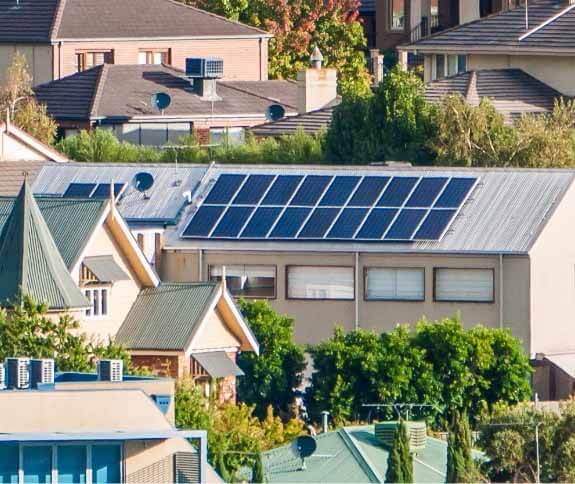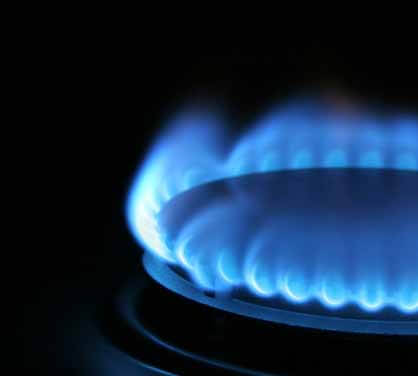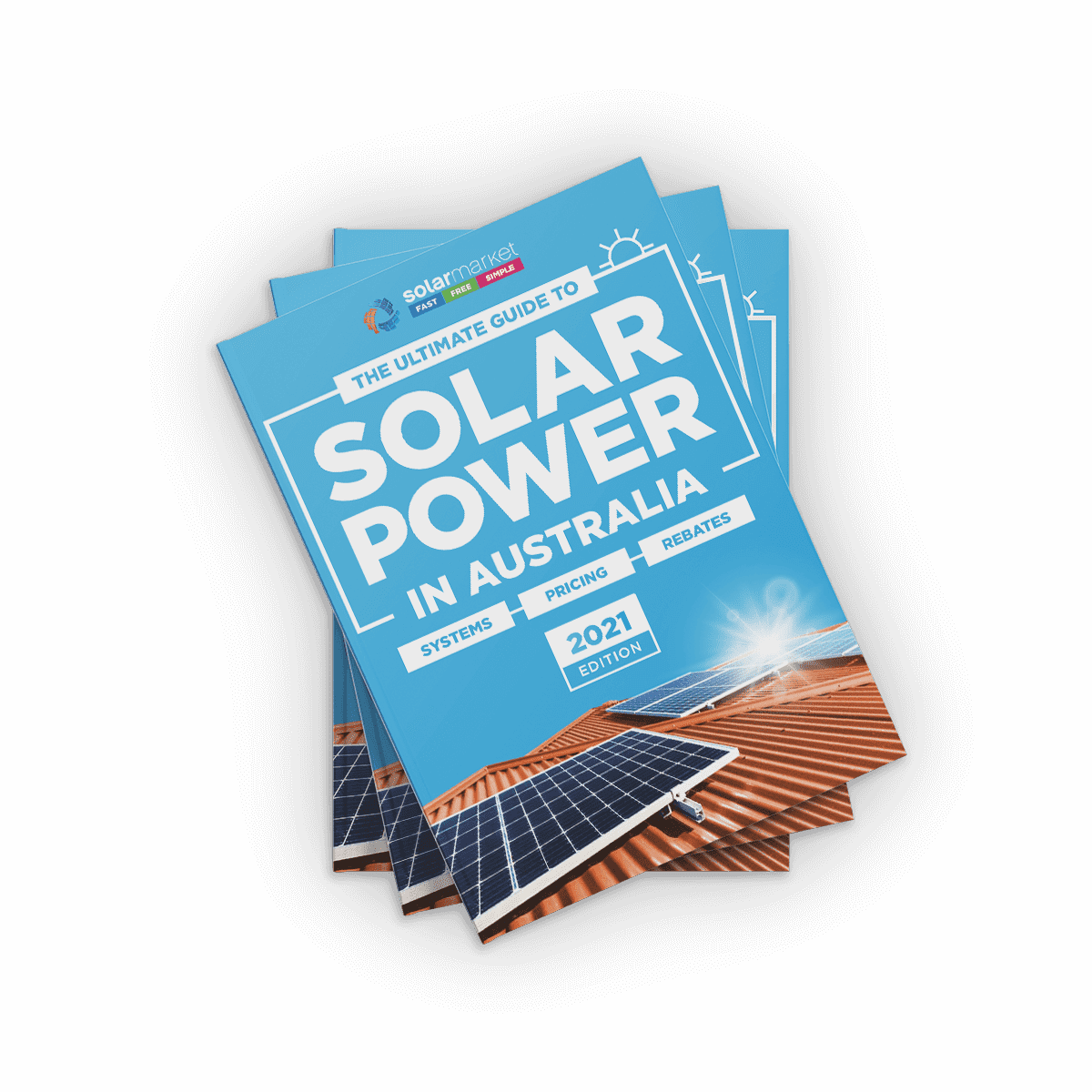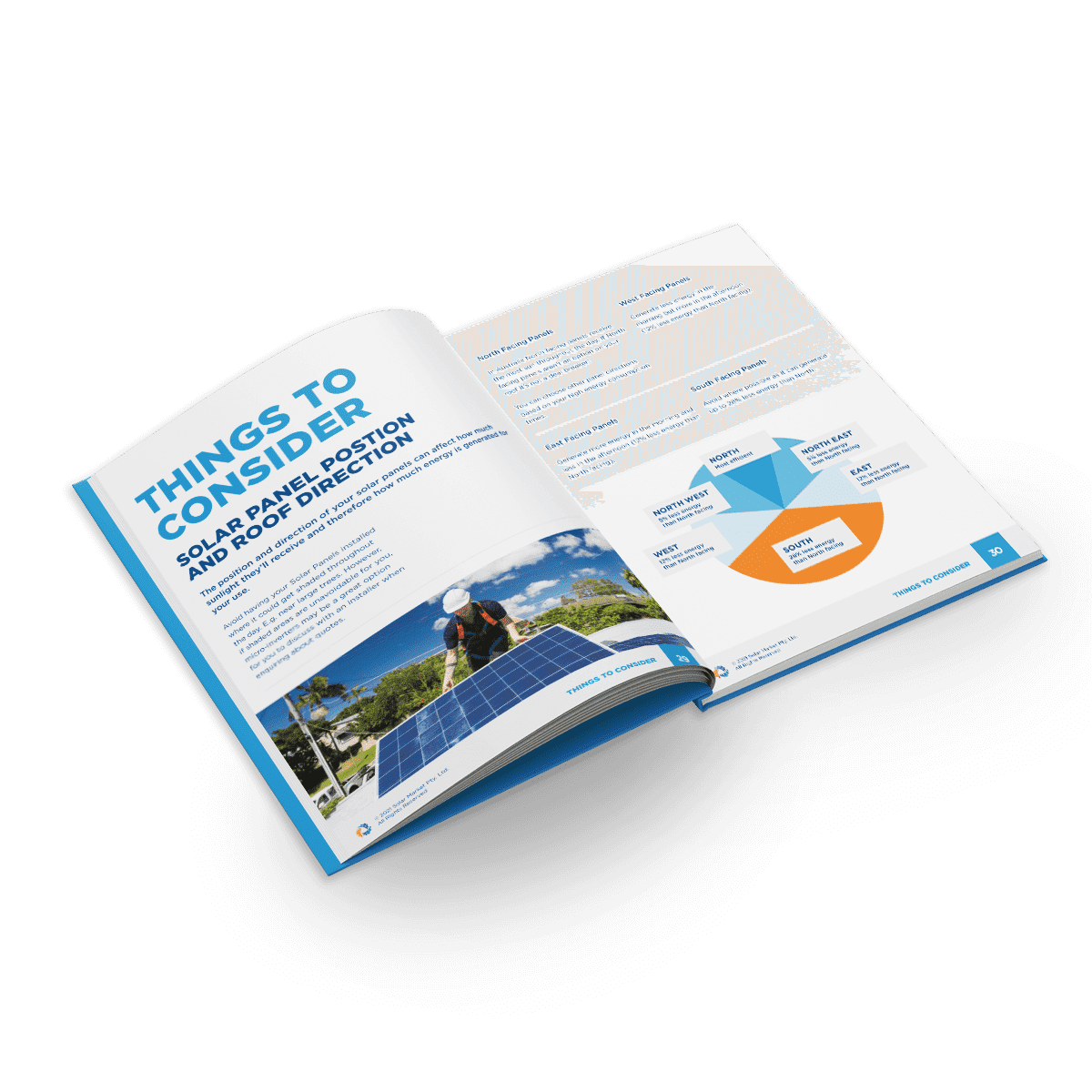There are two primary components that make up a solar PV system – the solar panels and the inverter. Here we are going to focus on solar panels and the different types available.
Solar panels absorb light from the sun, producing renewable energy in the form of solar electricity. There are three different types of solar panel options:
- Monocrystalline
- Polycrystalline
- Thin-film
Monocrystalline and Polycrystalline panels are the two most common types sold in Australia. The third type, called Thin-Film, are not common here, so you probably don’t need to worry about them (if you’re really interested in learning about thin-film panels, you can read a bit more about them below).
Both Monocrystalline and Polycrystalline solar panel options are reliable and efficient.
Of course, there’s always debate amongst industry folk claiming that monocrystalline panels are better than polycrystalline panels, and vice versa. However, the differences nowadays are super small.
Regardless of the type of panel, what’s more important is the quality of the make and model you choose and how well they are installed.
That said, let’s compare the differences between monocrystalline solar panels and polycrystalline solar panels so you can learn the lingo and understand your options when designing your solar PV system.
Monocrystalline solar panels
- Highly efficient
- Dark black colour
- Possibly a little more expensive than Polycrystalline
Monocrystalline panels are created from a single continuous crystal structure. You can identify it’s a Monocrystalline solar panels by looking at the solar cells which appear as a single flat colour.

Monocrystalline Solar Panel Manufacture
Monocrystalline panels are made through the Czochralski method where a silicon crystal ‘seed’ is placed in a vat of molten silicon. The seed is then slowly drawn up with the molten silicon forming a solid crystal structure around the seed. The rod of solid crystal silicon that is formed is then finely sliced and shaped into the solar cells you see making up a solar panel.
Polycrystalline solar panels
- Highly efficient
- Light or dark blue colour
- Occupy marginally more roof space than Monocrystalline for the same power output
Even if a Polycrystalline panel needs a little more roof space, if you have the roof space and the product you are comparing is a little cheaper than the Monocrystalline alternative, then it probably doesn’t matter which you choose.

Polycrystalline Solar Panel Manufacture
Polycrystalline starts as a silicon crystal ‘seed’ placed in a vat of molten silicon. However, rather than draw the silicon crystal seed up as with Monocrystalline the vat of silicon is simply allowed to cool. This is what forms the distinctive edges and grains in the solar cell.
Thin-film solar panels
- Less efficient than mono or polycrystalline
- Requires more space than mono or polycrystalline
- Solid black in appearance
Thin-film panels have lower power efficiency, meaning you’d need more panels, and therefore roof space, to produce the same amount of power that Monocrystalline and Polycrystalline options do.
Thin-film panels are a totally different technology to Mono- and Polycrystalline panels. A thin-film panel can be identified as having a solid black appearance. They may or may not have a frame, if the panel has no frame it is a thin-film panel.

Thin-Film Solar Panel Manufacture
Thin-film panels are made by depositing a photovoltaic substance onto a solid surface like glass. The photovoltaic substance that is used varies and multiple combinations of substances have successfully and commercially been used.
300 watt solar panels
The 300-watt solar panel is not as common as it used to be, as technology has improved. A typical residential solar panel installation today will use panels upwards of 350 watts, with 370-watt solar panels more common. 400-watt and larger panels are common for commercial installations.
A common size when installing solar panels in Australia today is a 6.6kW solar system. As an example, assuming 370-watt solar panels, this system would have 18 solar panels. If your panels get 8 hours of sunlight a day, you could expect the system to produce around 26kWh of electricity a day. This however isn’t a constant daily production. Production will change based on the seasons, where in Australia you are located and if your solar systems are ever shaded at certain times of the day.
Your solar panel installer will be able to provide you with the solar panel specifications, estimated production, and payback period for your PV systems, based on your home’s situation.
Monocrystalline Solar Panels vs Polycrystalline Solar Panels: Which is right for you?
Instead of worrying about whether you should choose monocrystalline solar panels over polycrystalline solar panels, start by checking to see if the solar panels you’re interested in have:
a) a good product and performance warranty, and
b) that the manufacturer of those solar panels has a decent presence in Australia (including a warranty service department just in case you need to make a claim).
This will ensure that you’re covered and confident that your solar panels will last the lifetime of your solar system.
No single solar panel technology could ever be considered the key to creating the ‘best solar panel’.
Cost, quality, efficiency and warranty vary so much between solar panel brands, the models they offer.
Instead, discuss your options with your installer, see what solar panels they can offer you, check out some reviews and go from there.
Solar panel installation
Your solar panel installation can make all the difference to how much you can lower your electricity bills and how fast those savings “pay back” your upfront install cost – so it’s key to find the right provider for your solar panel installation.
With a quality installer, you can be confident you are purchasing a solar panel system optimised for your home – both in terms of your electricity needs and your roof’s energy generation capacity.
With Solar Market, you can take all the hassle out of getting your solar panel installation at the right price.
We’ll arrange three solar panel installers to send you free no obligation quotes for you to choose from.
Fast, free, and simple, all you need to do is fill out our online form to discover how much solar panels cost you.
Top Brands Available In Australia
There are many different brands of solar panels available in Australia. If you want to find out more on the highly reviewed brands in Australia, click here.
Top Solar Panel Brands Available In Australia
There are many different brands of solar panel options available in Australia. If you want to find out more about the highly reviewed solar panel brands in Australia, click here.
Find solar panels in your area
We offer solar panel quotes across Australia, so wherever you’re located, we can connect you with SAA-accredited installers in your state.
With our no-obligation quotes, you’re never locked in – the choice is yours. Find your quote for your solar panel installation.
Solar panels Sydney
Learn more about solar panel installation in Sydney.
Solar panels Melbourne
Learn more about solar panel installation in Melbourne.
Solar panels Brisbane
Learn more about solar panel installation in Brisbane.
Solar panels Adelaide
Learn more about solar panel installation in Adelaide.
Solar panels Perth
Learn more about solar panel installation in Perth.
Solar panels Canberra
Learn more about solar panel installation in Canberra.
Solar panels Darwin
Learn more about solar panel installation in Darwin.
Solar panels Hobart
Learn more about solar panel installation in Hobart.
Solar Panels FAQs
How many solar panels you should install will depend on:
- when and how much electricity you consume
- the amount of roof space you have; and
- the wattage and efficiency of the solar panels you choose
If you want a 6.6kW system, which is a pretty common system size in Australia, and each panel is around 390 Watts, you would need 17 panels on your roof. Each panel will be around 100cm x 165cm in size. For 17 panels you will need around 28 square metres of roof space.
The panels can be located all in one spot facing the same direction, or split over 2 or 3 areas of your roof to capture the sun at different times of the day as it moves through the sky.
Depending on what times of the day you use electricity the most, it can be better to have your panels facing different directions:
- East if you’re a heavy morning user;
- West if you’re home in the afternoon.
North is always a safe choice.
Good quality solar panels should last at least 25 years. However, they do lose energy conversion efficiency over time, so you may consider replacing them earlier if the economics add up.
Many Australian households are getting an excellent return on their solar investment, with the savings on their electricity bill paying back the upfront cost of their system in less than 3 years! For so many Australians solar is a no-brainer.
Solar cell efficiency is the rate that a solar panel converts light energy – from the sun – into electrical energy – which you can use in your home to power appliances.
The average cell efficiency is 15 to 22%, meaning that is the proportion of sunlight that can be turned into usable electricity. More efficient solar panels produce more electricity per square metre.
The cell efficiency will vary between manufacturers and models, depending on the materials used and the quality of the build.
If you are using a 300-watt solar panel, you will need 17 panels to make up a 5 kW solar power system. If each solar panel is around 1 x 1.6 m, you will need just over 27 m² of roof space in total.
Many homes are now installing 6.6kW of solar if their roof has the space. A common solar panel is 390 Watts. In this example, you will need 17 panels, taking up around 28 square meters on your roof.
If you’ve got the roof space, it doesn’t really matter if you choose a 300-watt solar panel, 350-watt panels, 370-watt panels, 390-watt panels, etc.
The upside of going with a higher watt panel is that you can fit more panels and therefore produce more electricity from your roof. That said, you may not need the extra capacity depending on your energy usage.
That said, if you’re planning on adding a battery in the future, installing higher capacity solar panels with greater net energy output means you will have extra energy to store and use when the sun is not shining (provided you’ve got a battery big enough to store all that extra energy!).
There are 1,000 watts in a kilowatt.
Assuming 370 Watt panels, you will need 27 solar panels for a 10 kW solar power system.
If you’re using 390 Watt panels, you would need 26 solar panels.
If using 300 Watt panels, you would need 34 solar panels.
And so on….
Mostly, solar panels require very little maintenance and do not need to be cleaned. Only if you live in a very dusty environment or there is excessive bird poop would you need to clean your solar panels.
Generally, rain is enough to give your panels a clean.
If you really must clean your panels, use a hose to wash them off.
For persistent poop, hose the panel down, wait 10 minutes for it to soften, and then come back and repeat the process to get the remaining poop off.
Never ever stand on a solar panel!
If you’re worried that your solar panels look a little dirty, before getting on the roof first check your system monitoring to see if it is producing as it’s meant to (or check your electricity bill… if it’s still low you’re all good!). You may be pleasantly surprised that all is in order even if they look a little dirty.











